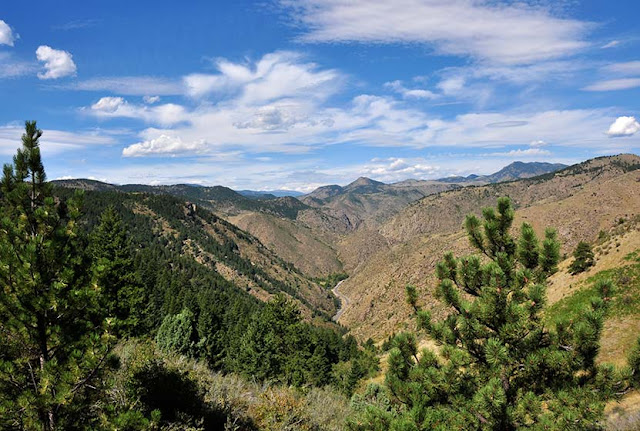FOLLOWING THE TRAIL OF HISTORY
One snowy evening last winter, we snuggled into our lounge chairs to watch a Ken Burns documentary on the Lewis and Clark Expedition. Doug was particularly interested because William Clark is an ancestor on his father’s side of the family. The documentary followed their famous route from the outskirts of St Louis along the Missouri and Snake Rivers, seeking passage to the Pacific Ocean. It told of their trials and tribulations and, most notably, their encounters with the peaceful Nez Perce tribe who took them in when they were starving and essentially saved their lives. The Nez Perce educated them about the land and traded horses and supplies so they could continue their journey. We had heard the tale of Sacajawea, a Shoshone who traveled with the Expedition as interpreter, but knew little of the Nez Perce tribe and wanted to learn more. Little did we know that on that snowy evening a seed had been planted for an exploration of our own come spring.
As March approached, we needed to finalize the route from Dinosaur National Monument in Vernal, UT to Vancouver, Canada where we planned to meet up with Doug’s sister and husband. Following the most direct route on the map, we noticed the towns of Lewiston, ID and Clarkston, WA were right on our way and directly across the Snake River from each other. The Nez Perce Reservation was nearby on the Idaho side. Remembering the Lewis and Clark documentary and our interest in the Nez Perce tribe, we knew we were meant to visit this historic area for a few days. We arrived at Lewiston, ID on May 10 and took a break from hiking and painting to immerse ourselves in the rich history surrounding us.
"Faith dare the soul to go further than it can see."
- William Clark
The Lewis and Clark Expedition was commissioned by President Thomas Jefferson shortly after the Louisiana Purchase to explore and map the newly purchased land and to find a practical route to the west. The Expedition lasted from May 1804 to September 1806 and was the first American expedition to cross the western portion of the United States.
In fall of 1805, the Expedition came across the Nez Perce tribe. After some trepidation, the Nez Perce invited them into their community, saving them from starvation and forming a bond of friendship with the promise of peaceful a co-existence with the peoples of the United States. Of course, before the end of the century, that promise would be broken.
Note: Nez Perce is a name given by early French Traders. The tribe's true name is Nimiipuu
"It makes my heart sick when I remember all the good words and the broken promises. The earth is the mother of all people, and all people should have equal rights upon it."
- Chief Joseph
In the year 1855, the Nez Perce Treaty was signed, which allowed the them to retain a large portion of their original lands in exchange for relinquishing almost 5.5 million acres of their approximately 13 million acre homeland with the promise (there’s that word again) that they could still hunt and fish on their former land.
However, in 1860 gold was discovered on Nez Perce land and all bets were off. Gold-seekers and settlers illegally settled on treaty land, founding the city of Lewiston. The U.S. government failed to support the Nez Perce Treaty and in 1869, a small group of Nez Perce were coerced into signing away 90% of their territory, leaving only a 750,000 acre Reservation. The majority of Nez Perce, including Chief Joseph, did not consider the new treaty valid and remained on their traditional land.
Tensions with the US government escalated over the next few years as settlers began disputing with the Nez Perce over land rights. Ultimately, in 1877, the US Calgary was called in and ordered all Nez Perce to move to the reservation within 30 days. An added complication emerged when a Nez Perce brave and a few friends murdered some settlers in revenge for their killing Nez Perce without being prosecuted for it.
What follows is both an inspiring and sad story as the entire “non-treaty” Nez Perce tribe, including 250 warriors and 500 members, began a fighting retreat towards the safety of Canada, knowing the US Calgary would escalate their actions to force them on to the reservation. This resulted in the Nez Perce Wars, which lasted from June to October, 1877 and covered 1,170 miles through Oregon, Wyoming, Idaho and Montana. Although a small band made it to Canada, 480 were finally forced to surrender only 40 miles from the Canadian Border. Click here to see a map of their journey: Map of Nez Perce Retreat
Bluff at Snake River, Clarkston, WY
As we drove through Nez Perce Reservation lands, we saw a modern day farming community which showed the resilience of the people to adapt to a changing world while retaining as much of their culture as possible. We learned that as a Tribe, they formed the Department of Fisheries Resources Management to actively preserve the Snake River and protect the salmon, originally a main food source of their people. Through their efforts, a salmon run that had declined to only 385 adult fish has been rebuilt to over 60,000.
We hope that by reading this, you will be inspired to research and learn more about the Nez Perce and their story of survival and adaptation.
We hope that by reading this, you will be inspired to research and learn more about the Nez Perce and their story of survival and adaptation.







Great post guys.
ReplyDeleteThanks, Jerry! Hope your travels are going well.
Delete